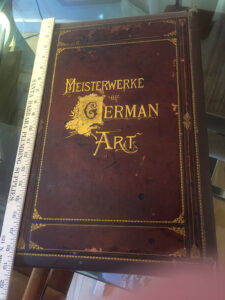 For years FR lugged around a pair of old, twenty-pound books, Meisterwerke of German Art by Carl Thonet Jutsum, 1883-4. He wonders if the collection of art pictured in these books is STILL recognized as “Masterpieces” (Meisterwerke).
For years FR lugged around a pair of old, twenty-pound books, Meisterwerke of German Art by Carl Thonet Jutsum, 1883-4. He wonders if the collection of art pictured in these books is STILL recognized as “Masterpieces” (Meisterwerke).
An EXCELLENT question, one stemming from the heart of what makes a work of art “immortal” or “important.” Why some works of art become beloved in some eras and despised in another. We need to broach the question of “what is a work of art?” We think of the pieces hanging in our great museums as “masterpieces,” will people considered them such in 200 years?
Reproduced Meisterwerke Art
These two illustrated tomes present a case study in visual culture. To discuss WHY, we must give recognition to the printmakers who reproduced these works, the engravers, etchers, and woodcut copyist of fine art. Yes, copyists engaged in this career to reproduce fine art from paintings, called ‘Reproductive Prints AFTER (fill-in artist’s name). A few great artists reproduced from the 15th to the 20th century include Raphael, Rubens, Carracci, Rembrandt, Vermeer, Van Eyck, Titian, Michelangelo…
In fact art lovers only SAW great works through the publication of prints AFTER a certain work of art. Without this army of copyists, our world of visual culture would lack vocabulary when speaking or looking at art.
For Example
The first volume of “Meisterwerke” states that NO Germanic art came before Christianity and uses copies of “great” works to reinforce that statement. As proof, the author, writing in the 1880s, states that until Irish Monks brought Christian Illuminated Manuscript to Europe, NO art existed. After German monks discovered Illumination (illustrating Holy Books) in Ireland in the 7th century, they added simple pen and ink drawings with color to illustrate THEIR manuscripts. The author gives, as evidence, two German Illustrated Manuscripts (814 AD), The Bible of St. Paul, and the MS of the Covent of Wessobrunn (815 AD). The author places the beginning of Germanic (called Teutonic) art with the advent of Christianity, which “frames” what the author MEANS when he chooses “Art.” Imagine the author’s reaction in 1908 when Johann Veran discovered the Venus of Willendorf, dating from 24,000-22,000BCE, now in the Museum of Natural History Vienna.
The reproduction of art pictured in many such compendia of geographically specific art reinforced cultural biases about what makes a work GREAT. ‘Meisterwerke’ is no exception. The author lauds the ‘realistic’ nature of German art as a Germanic trait visually expressed. A world of hurt proceeded from this kind of bias, but also worlds of good. Through copyist’s engravings, common folk visited the great works without travel, impossible for centuries. Other artists saw what other artists DID in other “schools.” Art so copied enjoyed a public forum for discussion and education.
Books like ‘Meisterwerke,’ used a team of etchers, who traveled to museums and private collections to COPY works. These copyists became “star-makers” though their expert engraving skills. Artist included in such a book came with established fame.
Fame? But for how long?
Once published, HOW LONG (historically speaking) did a work of art, as copied by a master engraver, remain a Masterpiece? Copyist existed since the Renaissance, so we have a good indication of two factors. First, book publishers who collected images to publish FROM fine copyists had GREAT influence over visual culture for centuries. Second, the art climate CHANGES, often reinforced by copies of art.
Great thinkers like FR have asked this same question: is a work of art “itself” only, or does it live only in copies?
I experienced an up-close exposure to this question when I worked with the eminent dealer Robert Strossi in Boston on a collection of woodcut engraver Timothy Cole, one of the BEST and perhaps one of the last great copyists of the late 19th and early 20th Centuries. Look at the collection at Strossi’s Brier Hill GallerStrossi’s Brier Hill Gallery online.
The massive two volumes, if sold, will fetch $390, because of the questions it raises, and the changed climate.
Hello,
I want to collect these two volumes. Who is selling this? Thanks.
Best regards
I acquired this beautiful set at auction and do not have the heart to put it in my shop where it will surely be destroyed by curious but careless hands!
Please contact me for details.
Hi REBECCA L NELSON,
I would like to collect your set. Please reply to my email so that I can get touch with you. Thanks.
Best regards